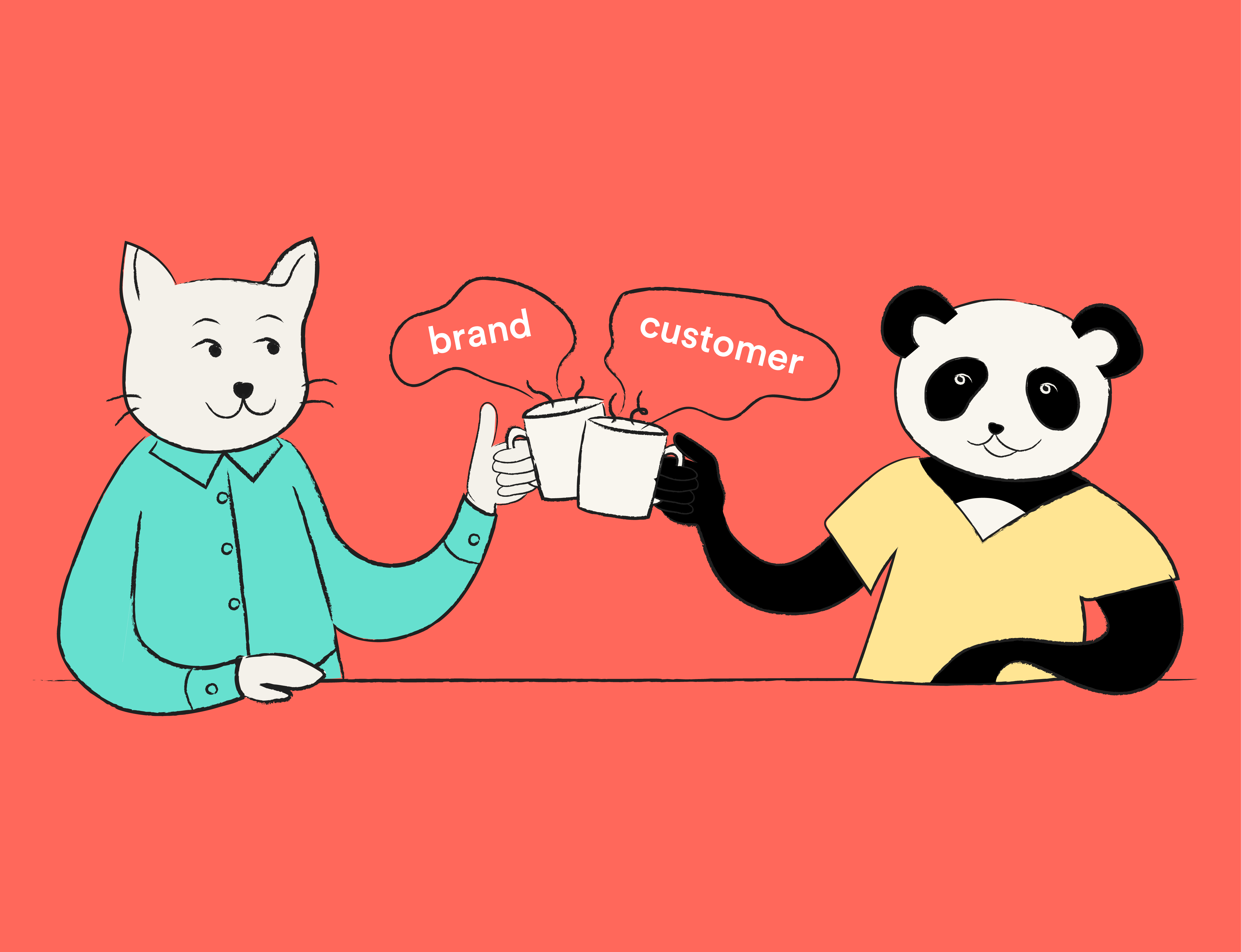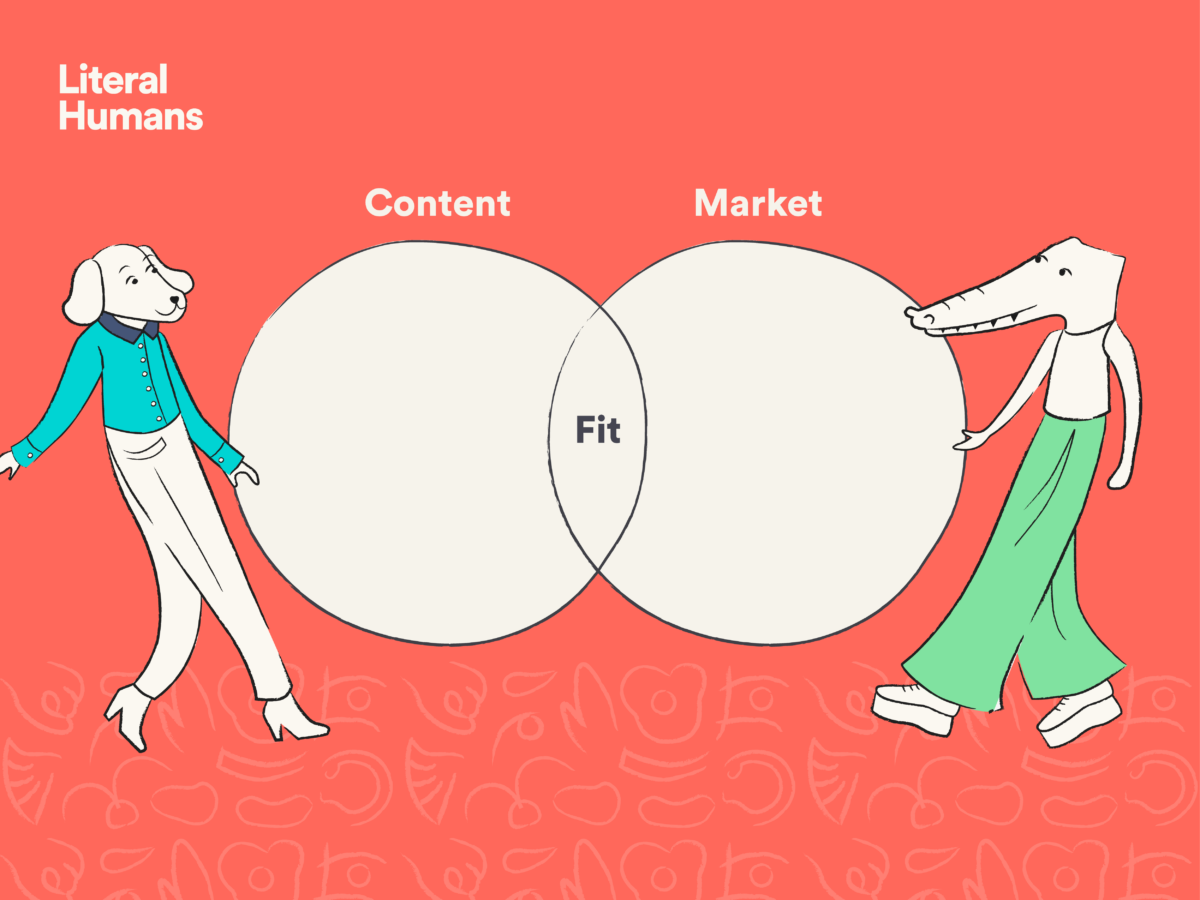As of May 2022, there were 9,932 martech solutions available to marketers globally.
That’s about thirty times the number of Sesame seeds on a Big Mac bun.
In this automation arms race, marketing — the one function that’s all about meeting customer needs — has become about everything else but the customer.
But effective marketing, the type that fosters trust and loyalty, MUST be customer focused. And this is the premise of human-to-human marketing (H2H).
Yes, not another industry fad or marketing buzzword (hands up, we’ve been guilty of this). But we think it’s the only way marketing should be done. And we’ll share our thoughts on the how and why in a bit.
If this is the first you’re hearing of it, consider this your beginner’s guide to human-to-human marketing.
We’ll look at how we arrived at this point where we must remind companies that customers are literal humans (hehe) and should be engaged as such. We’ll check out some brands that have gotten the hang of H2H and their results, and then we’ll cover tips and strategies for adjusting your marketing strategy to H2H.
There’s a lot to unpack, so let’s get going.
The evolution of marketing

“If you have a really good thing, it will advertise itself.” Not our words — Henry Ford’s. That sentence captured the auto manufacturer’s approach to marketing and advertising in the 1920s.
The company focused on creating a reliable automobile. And did very little ad-speak.
The ads they put in the papers were primarily text-only one-pagers emphasizing their expertise, the quality of the product, and the price advantage. Ford Motor Company altogether ceased advertising between 1917 and 1923. However, its dealers continued to spend on advertising.
This was the dominant approach to marketing in this era.
In the 30s, marketing became more visual. Companies started employing imagery to make their products more memorable as competition increased across industries.
Around came the 80s, and businesses started using ads to do all the talking. This was the era of sensational infomercials and catchy taglines.
With the rise of the internet in the late 90s and early 2000s, digital became a primary marketing channel. And companies sacrificed customer engagement for more reach. The focus on reach was important as audience attention became divided across several channels with different content needs.
A Semrush report revealed that Apple spent $64.8 million to appear in search ads in 2020 alone. But was rungs beneath Alphabet and Amazon on the ladder, who spent $774 million and $471 million, respectively. Ford spent $1.2 billion on ads in 2020.
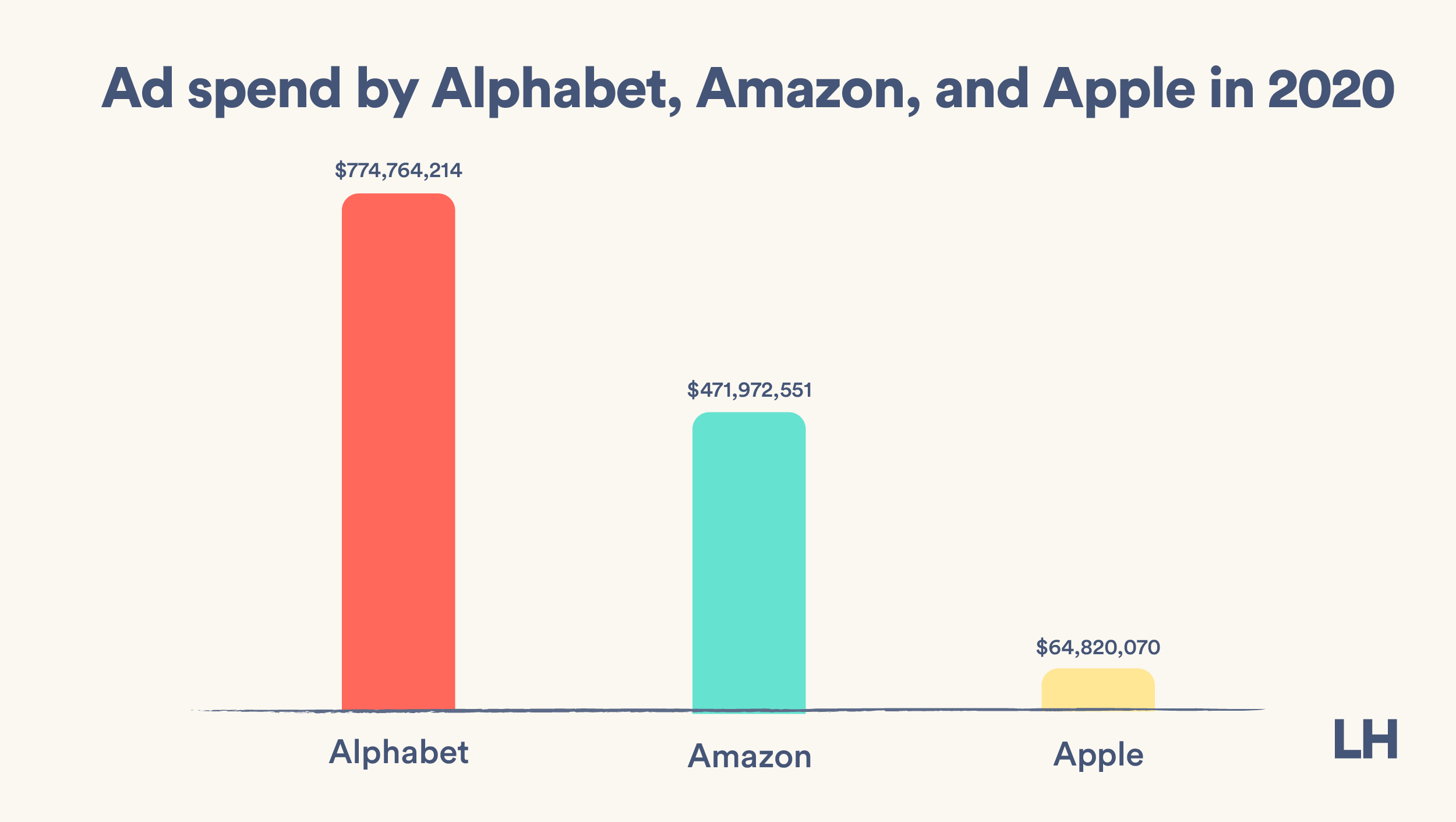
In the 2020s, brands are rediscovering the value of relationships as environmental and economic headwinds shift the power dynamics in favor of the customers.
This is where human-to-human marketing comes in.
What is human-to-human marketing?
The rise of martech meant an increased reliance on automation.
- If a customer wants to ask a question, there’s an FAQ page for that.
- Want to know about the brand values and mission? Check the website.
- Need help with the product? Text the chatbot.
It’s efficient. But every step the industry took towards automation took us farther away from a crucial communication element: the human factor.
No matter the industry, products, and services are made by people and for people. And human-to-human marketing flips the dominant robotic business-customer interactions on its head.
People interact with people; people engage with people, and people are essential to people.
Whether B2B or B2C, all roles and all audiences are people. Robots haven’t yet taken over our roles—and they can’t. Because human-to-human interaction forms a unique connection that can’t be replicated by anything else.
H2H marketing seeks to leverage that connection—to engage with customers as humans rather than as numbers on a CSV file.
In practice, it radically changes the approach to and process of brand communication. It informs the topics your brand decides to speak about and how you communicate them to your audience.
Human-to-human marketing vs. traditional marketing
Whereas H2H marketing speaks with customers, traditional marketing speaks at them.

Traditional marketing is loud and full of buzzwords. There are “rulebooks” to play by and “proven” calls to action to use. Although that worked for a while, years of gimmicky marketing have left a bad taste in consumers’ mouths.
70% of Edelman’s 2020 Trust Barometer Report respondents say brand trust is more important today than in the past.
Customer needs have also evolved from merely looking for their next purchase. Customers now need and search for niche solutions to support specific tasks.
For example, the average knowledge worker might spend the morning looking for a checklist to help with a task at work. And by noon, they are thumbing through the interwebs looking for how-to meal guides.
Even non-knowledge-workers have to search for things on the interwebs to help them with their jobs or even leisure activities.
The past few years left us all hyper-aware of our humanity. So, customers are holding the brands they patronize to a higher standard. People want to see authenticity, empathy, and loyalty more than clever taglines.
- Data from research by Stackla, a content marketing company, shows that 88% of consumers think authenticity is a key factor when deciding which brands they like and support.
- Millennials and Gen Z consumers want businesses to care about more than just their profits. And that’s a demographic that makes up about 42% of the U.S population.
- Gen Z alone has $44 billion in buying power, according to Google’s It’s Lit report. So, they’re impossible to ignore.
Now, adapting to H2H doesn’t mean throwing out your marketing strategy or ditching all industry jargon.
But instead of stiff ad-speak, H2H communication prioritizes personality. In real-life interaction, what makes communication delightful is humor, quirk, honesty, warmth, and empathy.
Most importantly, in real life, communication isn’t one-sided; it’s a two-way affair. Humanizing your brand means weaving these communication elements into every aspect of your brand messaging.
One way to do that is to create content experiences for your audience. Let’s check out how to do that.
How to create content experiences for users
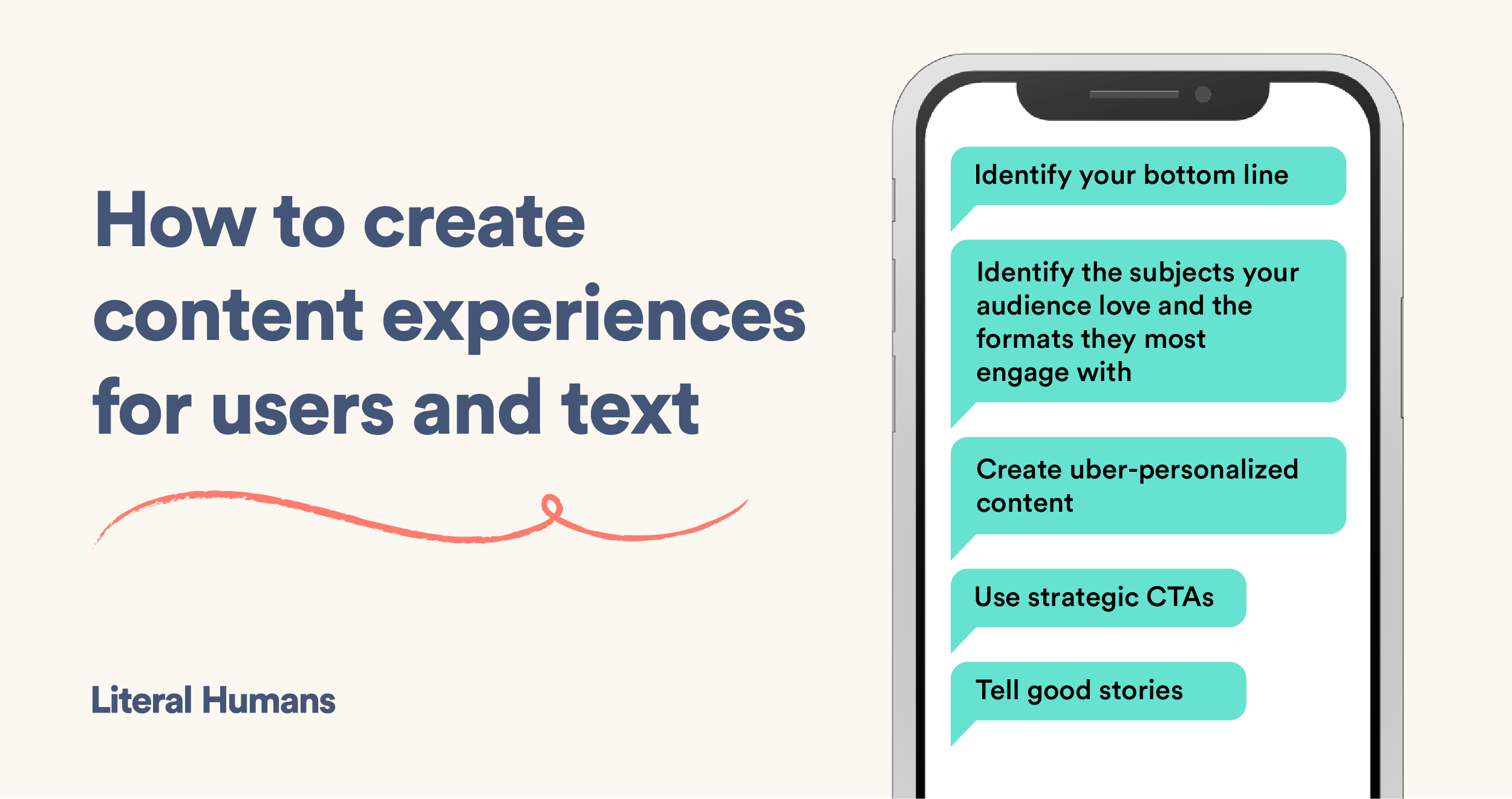
Creating humanized “content experiences” means optimizing your content for customer engagement across platforms. Because with H2H marketing, content is more than just promotional or strategic assets — they are conversation starters and dialogue nurturers.
H2H marketing seeks to bring the customer into the discussion. So your content pieces and brand messaging should be open-ended.
Naturally, this implies a few key things:
- First, identify your goals. Starting with a clear objective in mind will help you maintain focus and streamline your processes as you work toward achieving that objective. Are you looking to build awareness for a new product launch? Or tackle a misconception about your product’s benefits? Tying your content pieces and messaging to your end goal is key to building a great content experience.
- Next, take a step back to identify the subjects that interest your target audience and the formats that are most likely to resonate with them. Do they favor a 15-second TikTok video or a blog post? A community post on YouTube or an Instagram story poll? If you’re wondering how to figure out what works, you don’t have to. The solution is simple: ask your audience.
- After figuring out the subject and format, what’s next is creating personalized content based on the specific data you have collected. Do you know what’s interesting? There’s never only one right way to do this. Consumer needs and preferences are constantly changing, but that doesn’t have to be a bad thing. If you stay in conversation with your customers, you’ll continuously have direct data to tweak your approach as you go.
- Use strategic CTAs. Again, keep your bottom line in mind. If you’re optimizing for more website traffic, include CTAs that nudge your audience towards that action. It’d be counterproductive to add “subscribe to our YouTube channel” as CTA for a content piece that’s supposed to improve click-through rates. Not only does having multiple CTAs confuse your audience, but it also undermines your optimization efforts.
Check out our guide to creating memorable content experiences for more insights on the subject and ideas for implementation.
Now, one major factor that’ll determine the success of your H2H messaging efforts is your storytelling. While what you say is necessary, the context of your delivery is even more so. Here’s where storytelling comes in.
How to nail storytelling for H2H marketing
Humans love stories.
The right stories evoke emotion and resonate with people. And that’s a surefire way to create a connection with anyone. Here are some key chords to strike if you want to tell compelling stories:
- Appeal to emotions: One essential storytelling technique is to center your narrative around a universal sentiment — inspiration, empathy, drive, perseverance, personal development —and then weave in your product or service as a major player in the story.
- Show, don’t tell. People buy experiences, not things. So the best marketing materials don’t simply talk about how great, useful, or interesting a product is; they show it.
https://www.youtube.com/watch?v=G9TdA8d5aaU
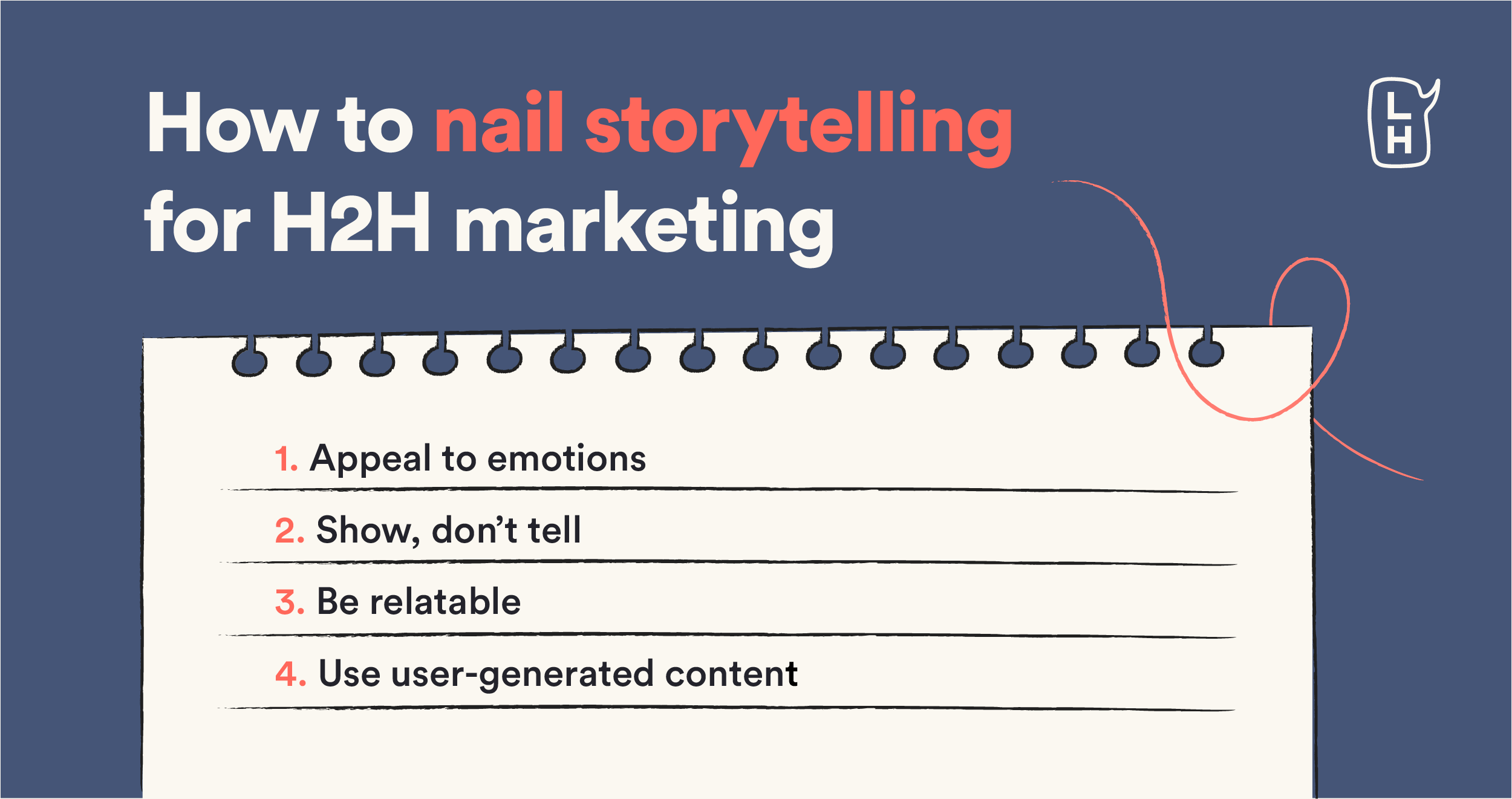
- Be relatable. It’s crucial to create stories around experiences your audience can relate to. Again, the trick is to appeal to a common emotion. Even if you’re telling a lofty, unrelatable story of becoming a $1 trillion company (hey, Google), find the common thread (“this started out in the garage. Follow your dreams”).
People will only like stories they can see themselves in. A Headstream report shows that if people love your brand’s story, 55% are more likely to buy from you in the future, and 15% would even buy the product immediately.
If you’re feeling overwhelmed by all this information, don’t be. What’s great about all of this is that customers are eager to engage in conversations with brands. Per data from the National Retail Federation, Gen Z consumers are keen to interact with brands they like.
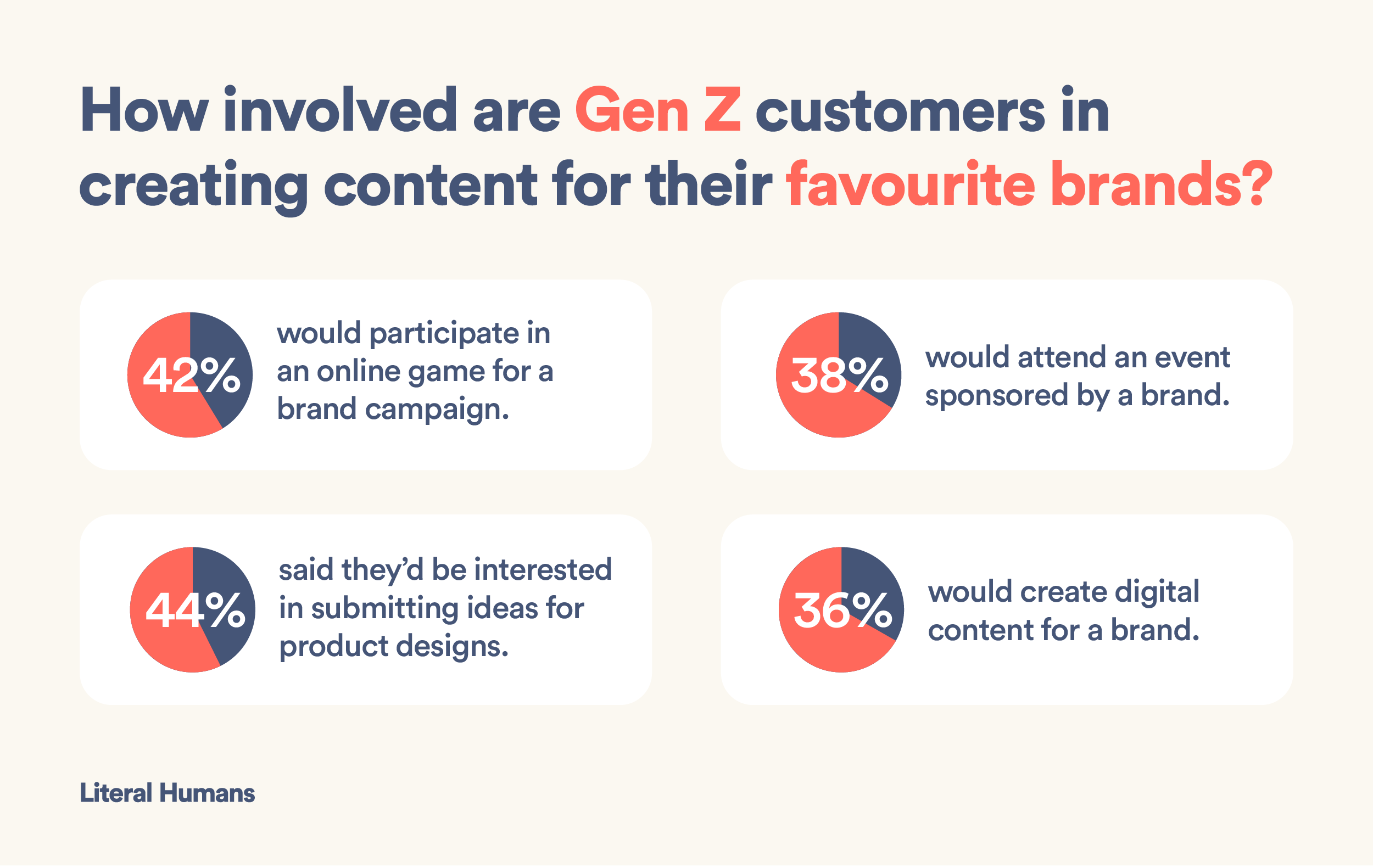
All of these bring us to our next and final tip for compelling brand storytelling:
- Use user-generated content. As the name implies, user-generated content (UGC) is content generated by users. Sorry, that was underwhelming. If you’ve ever made an unboxing video of a “cool” new product, written a review, or tagged a brand in an Instagram photo of their product, you’ve created user-generated content.
These are valuable for marketing because 88% of consumers trust user reviews as much as personal recommendations. And since research shows that a whopping 87% of buying decisions begin with online research, you want to make sure that your customers are having organic conversations about your product online.
One way to do that is to encourage online challenges and events. Or straight up ask for feedback on product and brand designs. Read more on user-generated content in our UGC deep-dive.
Now let’s check out a few examples of companies killing it with H2H strategies.
How successful companies are employing H2H strategies
We have previously featured ten companies winning at H2H marketing. From comic newsletters to user-generated content and giveaways, brands are getting creative with forming and solidifying relationships with their customers.
Another trend that’s working out is humanizing corporate philanthropy.
For example, for every pair of shoes bought on their website, TOMS Shoes donates a pair of shoes to a child in need. The brand calls it the “One-for-One” campaign, which is precisely the kind of message that appeals to a generation concerned with making the world a better place.
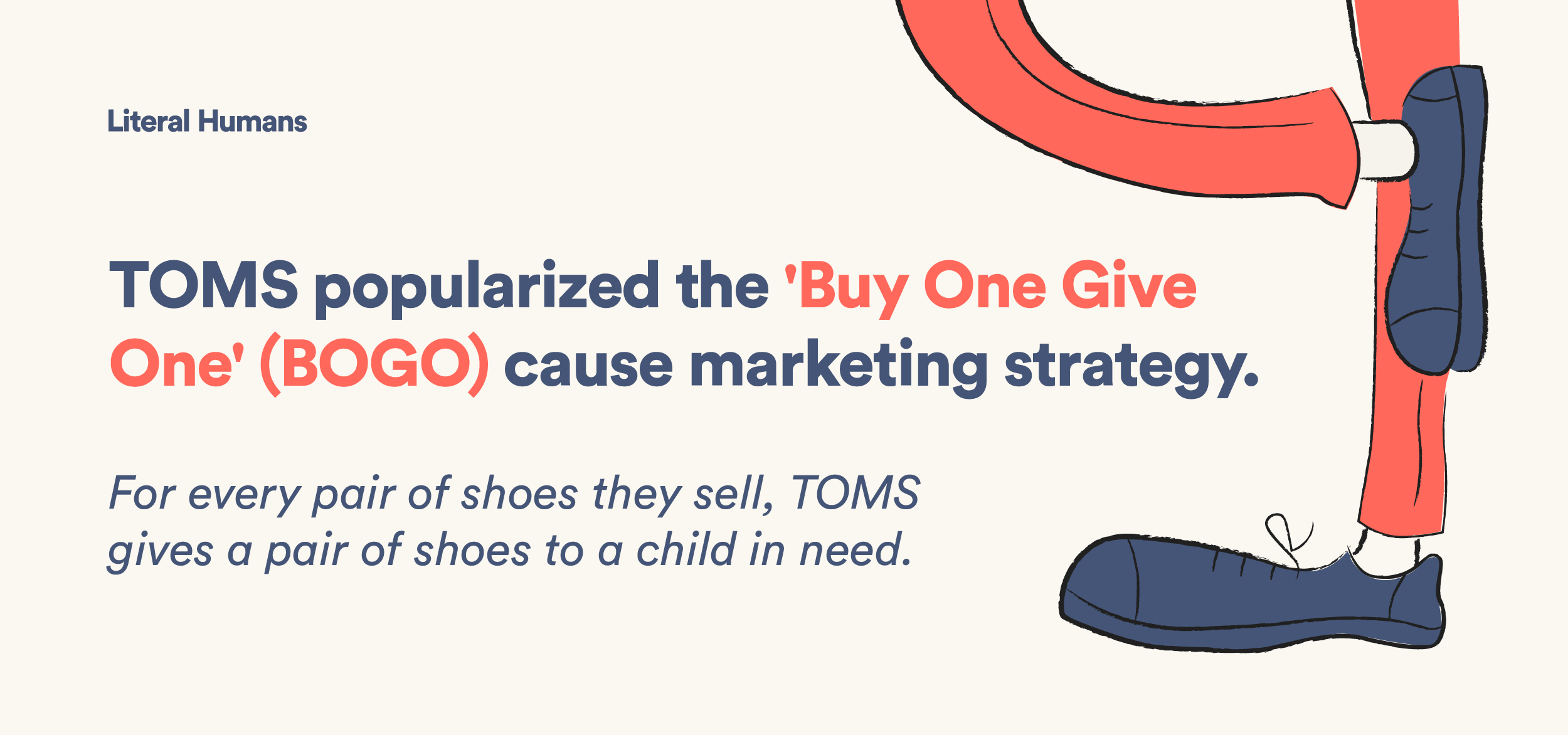
According to a First Insight report, Gen Z consumers and millennials make purchase decisions based on personal, social, and environmental values. 75% of Gen Zs think sustainable purchases are more important than brand names.
75% of millennials reported adjusting their purchase decisions to be more eco-friendly. And they think their investment choices can influence climate change.
Brands who have picked up on these preferences are responding with initiatives and policies demonstrating their support for these causes.
For example, Allbirds and Adidas are collaborating on creating a sports performance shoe with the lowest carbon footprint ever. It’s the same reasoning behind Walmart’s partnership with ThredUp, an online thrift store, to sell pre-owned clothing by big-name fashion houses like Anne Klein and Tommy Hilfiger.
Next up, and as a wrap-up, let’s look at some do’s and don’ts to help guide your transition to H2H marketing.
Do’s and Don’ts of H2H marketing
A caveat before we start: this isn’t an exhaustive list. But these will lay a firm foundation of values on which to build your H2H marketing strategies. Also, they’ll act as a guide for your subsequent relationship-building efforts.
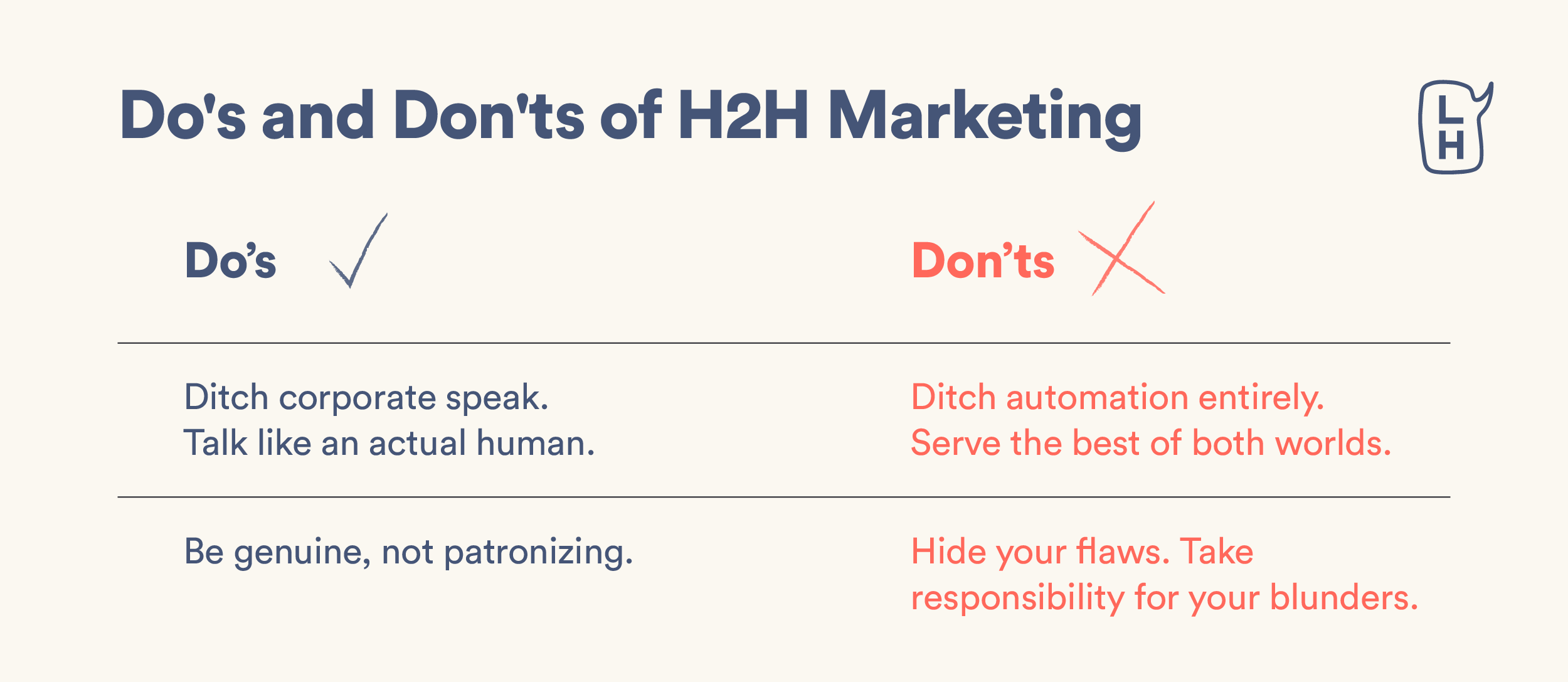
1) Do ditch corporate-speak
A certain tone of communication has been considered “professional” for the longest time. You know what we’re talking about: corporate America’s lifeless, robotic language.
Wikipedia puts it like this: “The use of corporate jargon is criticized for its lack of clarity as well as for its tedium, making meaning and intention opaque and understanding difficult,” which is a little ironic because that’s very similar to the corporate-speak we’re referring to.
Simply put, corporate talk is boring. No one talks like that outside of offices. Use plain, conversational language for brand communication, especially on social media.
2) Be genuine, not patronizing
Because H2H has started making waves as a “marketing strategy,” many brands will jump on the bandwagon and try to implement the “rules” of the game.
Brands may try to feign support for causes their customers care about to attract customer loyalty, but it’ll be easy to see through that ruse. Instead of approaching H2H communication as a means to an end, truly embrace the nobility of standing up for social issues. That way, attracting customers will happen seamlessly since people naturally bond over shared passions.
3) Don’t ditch automation entirely
While customers appreciate personal, human interaction, they also don’t want to give up the convenience of automation. Strive to offer the best of both worlds.
You can achieve that by humanizing your help pages and chatbots, for example. Introduce wit and humor in copy that would otherwise be stiff and downright miserable, like your Terms and Conditions page.
No one reads Ts & Cs, even with how important they are. And that’s because most people would rather sit on a thousand needles than read through all that legal speak.
4) Show your human side on social
One sure way to get customer engagement is to actively keep up conversations with your audience. H2H is about humanizing your brand just as much as you’re humanizing your audience.
Answer questions, respond to comments, engage with your followers’ profiles, post light-hearted, non-business content, use GIFs and memes, be slangy, share user-generated content, go live. Make sure you let your followers feel like actual humans are running the account, not bots in suits.
5) Don’t hide your flaws
Transparency is a huge part of genuine human interaction. And so are mistakes. It’s not uncommon for brands to sometimes make blunders or offend their audience.
The H2H approach to making those wrongs right is addressing them openly and sincerely. We already live in a world where it’s difficult to get genuine apologies from brands when things go awry, so any effort in that regard shines in contrast. If (or when) you mess things up (as we all tend to do sometimes), own it and make sincere efforts to make things right.
For example, Skittles recently live-streamed a 35-minute press conference to individually apologize to all 130,880 people who complained about the brand’s removal of lime Skittles from the classic bag. More memorable than a one-paged press release, don’t you agree?
https://youtu.be/4Pkrc1XUyvQ
Go back to the basics
H2H strategies apply to all marketing efforts regardless of industry. Whether you’re playing in B2B-Ville or B2C-burg, prioritizing human interaction is the way to build solid relationships with your customers.
To save yourself the trial and error, let us at Literal Humans handle your adjustment to H2H marketing. We’re humans (we swear), and more importantly, we’re experts in human-to-human marketing (and our humans) and have results to show for it.
Book a strategy session today, and let’s show you how we can work the same magic for your brand.

